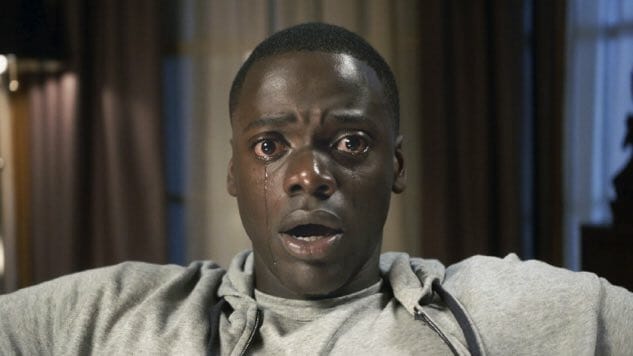The Best Horror Movie of 2017: Get Out

This post is part of Paste’s Century of Terror project, a countdown of the 100 best horror films of the last 100 years, culminating on Halloween. You can see the full list in the master document, which will collect each year’s individual film entry as it is posted.
The Year
Another year with an incredible volume of horror releases, 2017 displays pretty much everything that has been great about the genre in the back half of the 2010s in particular. There’s just such a wealth of indie horror releases here, from ones that got a fair amount of attention (Raw, It Comes at Night), to notably weird, underseen movies like Prevenge that seemed to come and go in the blink of an eye. It’s a year of pretty serious, cerebral horror films (the words “prestige horror” and “elevated horror” were being thrown around a lot by this point), but there’s always the occasional Happy Death Day to lighten things up.
Obviously, you can’t discuss 2017 in horror cinema without acknowledging It, a film that kicked down the doors of the American box office and completely redefined the upper ceiling of how much an undeniable horror story could ever hope to gross. It was a perfect storm moment of accessible (and memorable) Stephen King source material, faithful adaptation, perfectly polished direction from Andy Muschietti and outstanding performances, particularly by an emergent Bill Skarsgård as the slavering Pennywise. It was, in short, exactly what it needed to be to kickstart a sensation and a Stephen King revival on both the big and small screens, which has seen a copious number of projects launched in the months that followed It taking in a global $700 million haul. Unfortunately, as it tradition in adaptations of this story, It: Chapter 2 couldn’t quite keep up the momentum, but that’s to be expected when practically all fans prefer the “Losers as kids” portion of the story to begin with.
A strong contender to possibly unseat Get Out this year is little-seen Irish chiller A Dark Song, a film that explores how much faith and effort a broken person may be willing to invest in the hopes of achieving what would otherwise be impossible. The film follows a grieving mother, who wishes to contact her murdered son from beyond the grave, as she commits herself into the hands of an occultist who says he can achieve this result, but only at the greatest of costs. In order to succeed, this woman will need to partake in a months-long ritual in an isolated cabin in the Welsh countryside, where both she and the audience must battle against the insidious, creeping doubt that this entire activity is a sham, and that the occultist must be insane. Steve Oram, also excellent in Ben Wheatley’s 2012 film Sightseers, gives a wonderfully nuanced performance here as the irascible spiritualist who may or may not know what he’s doing, as the film builds to a transcendent, highly satisfying conclusion.
Cerebral, intimately disturbing horror is really the flavor of the day here, present in the post-apocalyptic paranoia of It Comes at Night, the seemingly Martin-inspired vampire story The Transfiguration, the unconventional ghost plot of Personal Shopper and the stomach-churning collegiate cannibalism of Julia Ducournau’s stunning coming-of-age movie Raw, the latter of which might well have inspired a few new vegetarians. This is an era of emerging filmmakers making bold, unrestrained horror features, whether they’re getting into limited release or existing solely in the streaming sphere, like Mike Flanagan’s Gerald’s Game.
This is also, to date, the high water mark for the horror genre, in terms of overall box office gross. Driven by It, and with big totals lumped on by Get Out and Split in particular, 2017 made a strong argument that even after a century, audiences are more ravenous for horror cinema than ever.
-

-

-

-

-

-

-

-

-

-

-

-

-

-

-

-

-

-

-

-

-

-

-

-

-

-

-

-

-

-

-

-

-

-

-

-

-

-

-

-








































